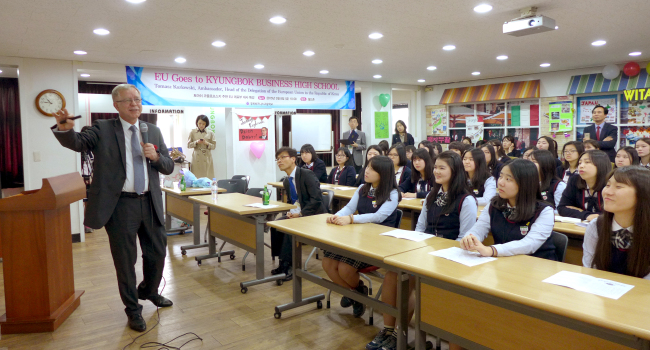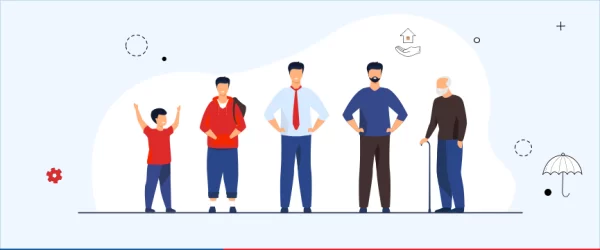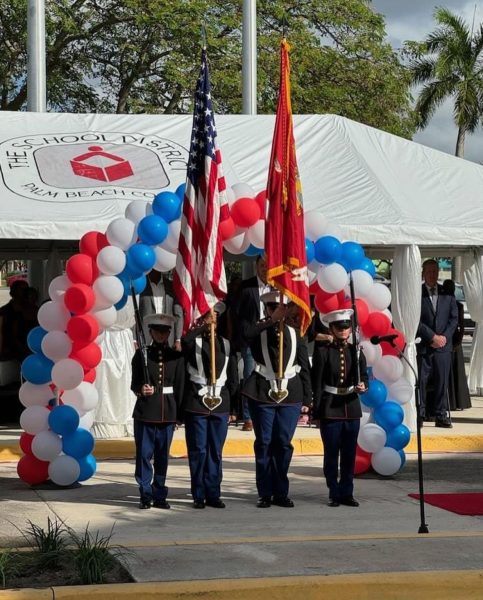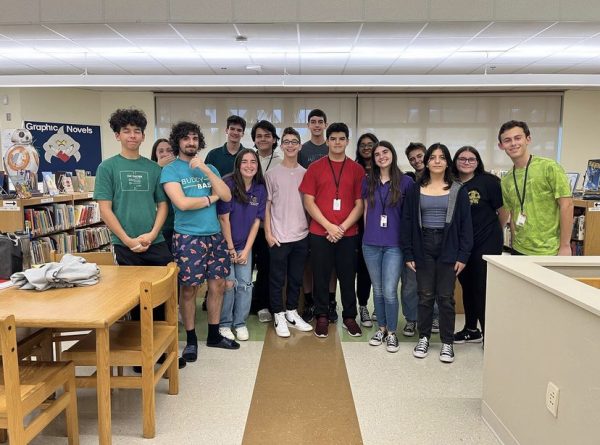U.S. Students Continue to Fall Behind When Compared to Other Nations
Some other nations tend to emphasize a more specialized educational track for high school students such as the Kyungbok Business High School in Seoul, South Korea.
It has been reported numerous times that American students historically do not fare well in comparison with other leading developed countries on standardized tests and other areas of academic measurement. Americans might be perplexed as to how arguably the most powerful country in the world has an educational system that is seemingly lacking. The truth is, American education certainly is distinct from that of other countries, and in some regards, the U.S. does have catching up to do.
One of the most frequently cited international tests is the Programme for International Student Assessment (PISA), which measures reading, math, and science literacy among 15-year-olds in dozens of developed and developing countries every three years. According to the New York Times, “The PISA does not assess what teenagers have memorized. Instead, it asks them to solve problems they haven’t seen before, to identify patterns that are not obvious and to make compelling written arguments.” The PISA results from 2015 placed the U.S. as 38th out of 71 countries in math and 24th in science. These underwhelming scores mean the U.S. is below average for the developed world in math and average in science and reading.
Amanda Ripley from the New York Times writes, “The PISA reveals brutal truths about America’s education system: Math, a subject that reliably predicts children’s future earnings, continues to be the United States’ weakest area at every income level. Nearly a third of American 15-year-olds are not meeting a baseline level of ability.” PISA data includes scores from private school students, displaying that even America’s most privileged teens are still scoring below their peers in other nations.
A Pew Research Center survey from 2015 reported that only 29 percent of Americans rated their country’s K-12 education in science, technology, engineering and mathematics (STEM) as above average or the best in the world. A companion survey of scientists found that 46 percent said K-12 STEM in the U.S. was actually below average.
The United States is among the world’s leading spenders on education, but apparently it is not paying off. “We throw more money at our schools than just about any other country, and what do we get? For our K-12 school system, an honorary membership in the Third World,” argues Professor F. H. Buckley in a Fox News opinion column. Hyperbole aside, his point that the U.S. is gradually falling behind other top performing countries is on target.
So what is it that other countries are doing that the U.S. is failing to? Typically, high-performing nations have worked to make teaching a more prestigious and selective career, directed more resources to their neediest children, enrolled the most children in high-quality preschools, and implemented rigorous, consistent standards across all classrooms. So far, the U.S. has only managed to employ one of these by setting up the Common Core State Standards for more challenging learning goals in reading and math.
East Asian countries account for the majority of nations with high-average performance. Shanghai, Singapore, Hong Kong, and South Korea rank in the top ten on the PISA, and each has very few of its students scoring at the lowest levels. According to the Atlantic’s Marc Tucker, East Asian countries are committed “to the idea that all students can and will meet high standards as they progress through the years.” Specialized teachers are hired to help students who are behind and struggle on their diagnostics. “The teachers understand that they are expected to do whatever is necessary to get students…back up to speed as soon as possible. If that means coming into school earlier, staying longer, or coming in on Saturday, then that is what they do,” asserts Tucker.
Students all over Finland also perform remarkably well on the PISA. The success of the Finnish educational system could be attributed to that fact that Finnish schools must use the same curriculum for all students. Other noted characteristics include light homework loads, no classes available for gifted students, very little standardized testing, and a comprehensive preschool program focused on socializing rather than academics. Grades are not given until high school, and class rankings are not compiled. Teaching is a competitive profession in Finland, with teachers needing a master’s degree. Furthermore, students are separated into academic and vocational tracks during the last three years of high school, and just like in other European Union countries, college tuition is free.
There seems to be a tendency among European high schools to be quite career-oriented. For instance, when students reach high school in Italy, they can choose between a path focused on history and linguistics or on math and science. This means that students often already have a career goal in mind and are taking classes that will be beneficial for that specific area of expertise. This is in contrast to the U.S., where students can choose from a great variety of subjects and basically have the freedom to create the class schedule they want.
In Germany, students are sorted into different types of high schools based on their academic achievement and future plans. There is a “hauptschule” for students with average or below average grades who will likely not attend a university. Meanwhile, the “realschule” is typically for future technicians, and the “gymnasium” is for university-bound students.
Another distinction is that European and South American students remain in the same class with the same kids every day, year after year. This results in the classmates being closer and more bonded than in typical U.S. classes. Olympic Heights senior Natalia Vallejos gives similar accounts of when she attended a private school in Colombia for sixth and seventh grade. She notes that the schools were smaller, “making it easier for teachers to interact with students in an empathetic way. It becomes an actual family somehow.”
Vallejos also remembers that standardized tests are not administered as frequently in Colombia as they are here; the only major one is an equivalent to the SAT for college. Everything on tests is typically free response and critical thinking, with the only multiple choice questions appearing on semester exams. Additionally, she proclaims, “In Colombia, all students take the same classes, and a normal schedule has about 10-12 different subjects. In the U.S., the students adjust their schedule individually and have about seven classes or less.”
OH sophomore Kaivin Im lived in Germany and attended first through fifth grade there. He recalls school ending “at different times every day.” Schools in Spain can also have interesting schedules, with some having split session days where students can go home during a break in between classes. Im also says, “Compared to American schools, Germany has really advanced classes at young ages. You can take high school classes in middle school.” As for differences in homework and tests, Im states that there is less homework in Germany, but work has to be shown for everything. Tests are usually without scantrons, and there is more of a focus on writing and oral exams. Im believes that school was more difficult in Germany, as all subjects felt easy to him when he came to the U.S.
The AP, IB, and AICE courses that are prevalent in America are also offered at some international high schools. Britain has A-level classes and exams. But in general, it seems as if high school classes in foreign countries are already made to be more advanced and geared towards college readiness.
Europeans also learn about certain topics differently than Americans. Sex education is mandatory throughout western and northern Europe, and it is taught in a more practical and less strictly biological manner than it is here. Some countries emphasize things like consent and navigating relationships; meanwhile, there are U.S. states that teach abstinence-only and do not even teach about contraceptives.
Also, Europeans are a lot better at geography. One in ten Americans aged 18-24 could not even find the U.S. on a map in one National Geographic survey. Not only do all Europeans have to learn English as a second language, but many countries also require students to learn another foreign language. In America, the average high school graduate takes less than two years of a foreign language and can hardly place a restaurant order in that language. A quarter of all Europeans can hold a conversation in two or more foreign languages.
What American schools may lack in some areas, they make up for in fun and involvement. U.S. schools are notorious around the world for their clubs, school spirit, sports, and traditions such as pep rallies and football games and prom. In Europe, there are usually no school sports teams, although gym classes are mandatory every year. Students play for city teams or clubs rather than for their school. Kaivin Im recounts, “Activities after school were more independent. You would have to manage most of the things, like transportation, by yourself. Most activities were not at school.”
Clearly, the American school experience is unique from the rest of the world. There may be some academic disadvantages, but students are also offered more independence and variety of choices. Students learn how to be leaders and work together in clubs, sport teams, and other extracurriculars. Even the education minister of Singapore acknowledges, “America’s is a talent meritocracy, ours is an exam meritocracy. There are some parts of the intellect that we are not able to test well, like creativity, curiosity, a sense of adventure, ambition. … These are the areas where Singapore must learn from America.”















